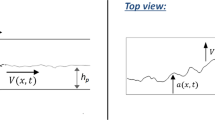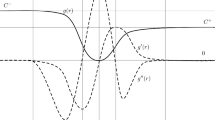Abstract
The kinetics of thermofluctuational development of a single crack is approximated by a homogeneous Markov process. Considering an ensemble of non-interacting cracks, we calculate the distribution functions of the dimensions of the crack and of the longevity τ of identical samples under isothermal creep conditions due to the randomness of thermal fluctuations and of structural inhomogeneities of the samples. The connection between these distributions is discussed. The results are confirmed by available experimental data. It is shown that the scattering of τ usually observed in experiments reflects the thermally activated nature of the fracture process.
Résumé
En utilisant un processus de chaîne homogène de Markov, on obtient une approximation du développement d'une fissure simple sous des fluctuations thermiques. En considérant un ensemble de fissures sans interactions, on calcule les fonctions de distribution des dimensions de la fissure ainsi que la durée de vie d'éprouvettes identiques, sous des conditions de fluage isotherme dont le caractère aléatoire est dû à des fluctuations thermiques et à l'hétérogénéité structurale des éprouvettes. On discute la relation qui existe entre ces fonctions et on trouve une vérification des résultats de l'analyse dans les données expérimentales disponibles.
On montre que la dispersion de la durée de vie que l'on observe au cours d'essais est le reflet de la nature thermoactive du processus de rupture.
Similar content being viewed by others
References
S. N. Zhurkov, Int. Journ. Fract. Mech., 1 (1965) 311.
S. N. Zhurkov and B. N. Narzulayev, Journ. Tech. Fiz., 23 (1953) 1677.
S. N. Zhurkov and T. P. Sanfirova, Journ. Tech. Fiz., 28 (1958) 1719.
T. B. Boboyev, V. R. Regel and A. I. Slutsker, Problemy prochnosti, 3 (1974) 40.
V. R. Regel, A. I. Slutker and E. E. Tomashevsky, Uspekhi fiz. nauk., 106 (1972) 193.
S. N. Zhurkov and V. E. Korsukov, Journ. Polymer Sci., Polymer Phys., 12 (1974) 385.
V. Schmidt and V. Betekhtin, Fit. tverd. tela, 15 (1973) 1235.
T. Yokobori, Journ. Phys. Soc. Japan, 6 (1951) 78, 7 (1952) 44, 48.
V. V. Bolotin, Problemy prochnosti, 2 (1971) 13.
V. A. Petrov and A. N. Orlov, Fiz. tverd. tela, 15 (1973) 3371.
B. V. Gnedenko, Probability theory (in Russian), Moscow (1961).
Kai Lai Chung, Markov chains with stationary Transition Probabilities, Springer-Verlag, Berlin, Göttingen, Heidelberg (1960).
M. S. Bartlett, An Introduction to Stochastic Processes with special Reference to Methods and Applications, Cambridge University Press (1955).
H. Bateman and A. Erdély, Tables of Integral Transforms, 1, New York, McGraw Hill, (1954).
V. A. Petrov and A. N. Orlov. Int. Journ. Fract., 11 (1975) 881.
A. M. Freudenthal, in Fracture, Ed. H. Liebowitz, Academic Press, New York and London, (1968) 592.
V. A. Petrov and A. N. Orlov, Fiz. tverd. vela, 17 (1975) 787.
Author information
Authors and Affiliations
Rights and permissions
About this article
Cite this article
Petrov, V.A., Orlov, A.N. Statistical kinetics of thermally activated fracture. Int J Fract 12, 231–238 (1976). https://doi.org/10.1007/BF00036980
Received:
Issue Date:
DOI: https://doi.org/10.1007/BF00036980




